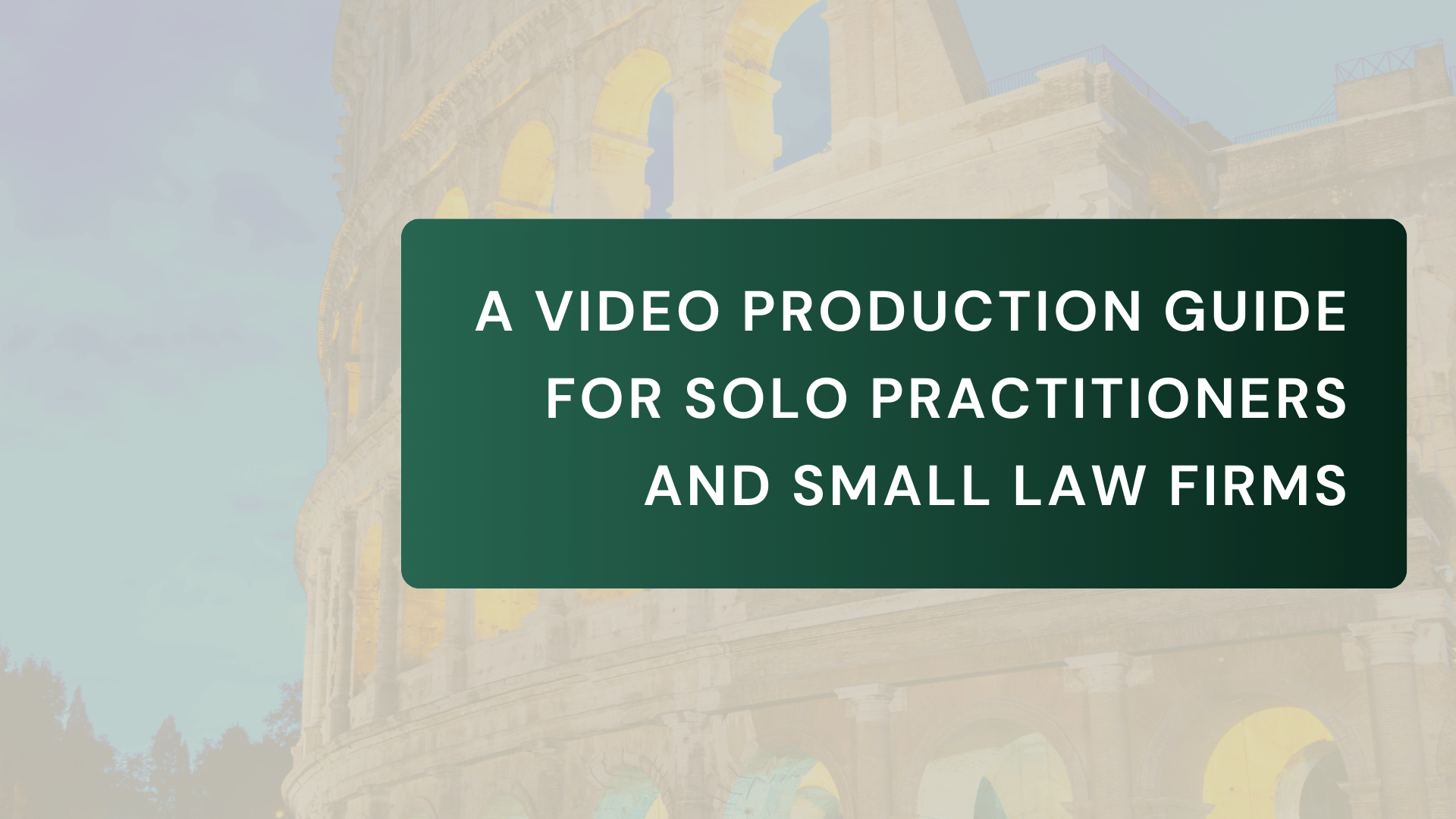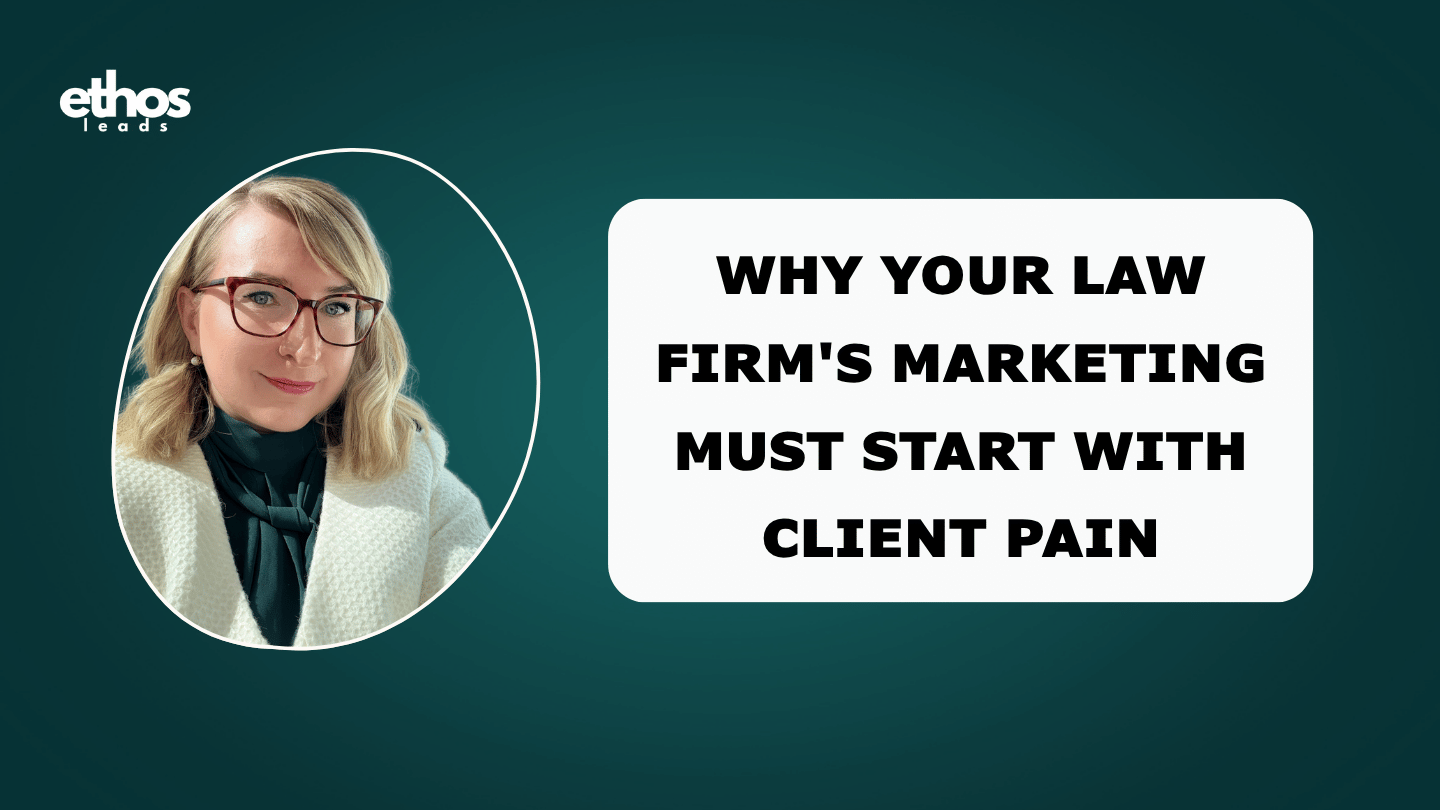Producing and Optimizing Videos
- Video
- 11 mins
A Video Production Guide for Solo Practitioners and Small Law Firms
Creating high-quality videos doesn't require a Hollywood budget.
This guide empowers solo practitioners and small law firms to use the power of video storytelling and attract clients without breaking the bank.
Pre-Production: Planning for Success
Before hitting record, meticulous planning is essential. Here are some valuable pre-production tips to set you up for success.
- Define Your Objectives: Before you start recording, clearly define the purpose of your video. Are you aiming to introduce your expertise in corporate law, showcase your track record in intellectual property cases, or address common legal challenges faced by your target audience? Having a clear objective will help you structure your content and deliver a focused message. Here are 10 Video Ideas for Lawyers to get you started.
- Know Your Target Audience: Identify your ideal clients. Are you a champion for startups navigating complex regulations? A trusted advisor for families facing estate planning challenges? Tailor your message to their specific needs.
- Professional Yet Approachable: Strike the right balance between professionalism and approachability. Aim for a friendly and trustworthy demeanor, fostering a connection with potential clients.
- Craft a Compelling Script: Develop a concise and engaging script that highlights your ideal client's pain points and positions you as the trusted solution. This will ensure that your message is coherent, structured, and easy to follow. If you need inspiration, you can use this Prompt to create your video script.
- Teleprompter for Confidence: Feeling apprehensive on camera? Many applications like Teleprompter Pro allow you to import your script, keeping it conveniently in front of you during filming. No more awkward pauses or forgotten lines!
- Setting the Stage: Choose a quiet, well-lit space with minimal distractions. Opt for a clean and professional background. Consider decluttering your office or utilizing a virtual background for a polished look.
- Essential Equipment: Your smartphone with a high-resolution camera is your primary tool. Invest in a stable tripod for shake-free footage. For enhanced audio quality, consider an external microphone or a lavalier mic.
Filming with Confidence
Now that you're prepared, let's begin filming!
- Project Confidence: Maintain good posture, make eye contact with the camera, and speak clearly and confidently. Consider incorporating visuals like slides or graphics to keep viewers engaged.
- Lighting is Key: Natural light is ideal. While recording, face the window with natural light. If unavailable, a Ring Light with a Tripod Stand provides even lighting and eliminates harsh shadows.
- Speak with Enthusiasm: Speak clearly and with enthusiasm. Use the script uploaded in your Teleprompter for a smooth flow.
Post-Production Polish: Elevate Your Video
- Editing Magic: Tools like Canva offer fantastic editing features for trimming videos, adding text overlays, and incorporating background music. Don't forget to include your brand colors and logo for recognition.
- Music for Impact: Background music can elevate the professionalism of your video. Choose music that complements your voice (not overpowers it). Consistency is key – use a similar music style across all your videos for brand recall.
- Compelling Titles & Descriptions: Write a video title that grabs attention and includes relevant keywords for search optimization. Add a clear description summarizing your services and a call to action.
- Captions for All: Services like Captions.ai allow you to add captions, making your videos accessible to a wider audience.
- Distribution and Promotion: Share your videos on YouTube, LinkedIn, and your website. Promote it through email marketing campaigns and relevant online directories.
Pro Tips for Standing Out from the Crowd
- Conciseness is Key: Aim for videos under 90 seconds to hold viewers' attention.
- Focus on Value: Address your target audience's pain points and offer solutions.
- A Clear Call to Action: Tell viewers what you want them to do next, such as scheduling a consultation on your website.
- Start Simple, Scale Smart: Begin with short, introductory videos using your smartphone camera and free editing tools. Focus on delivering helpful and authentic content.
- Social media optimization: Edit videos in popular social media platform aspect ratios (e.g., vertical 9:16 for LinkedIn, horizontal 16:9 for YouTube) to maximize reach.
- Topic Grouping: Plan your recording sessions strategically. Group similar topics together to maximize editing efficiency.
- Batch Recording: Recording multiple videos in one session helps maintain your "presenting" mindset. This eliminates the need to constantly ramp up and down before each recording, saving valuable time. It allows you to pre-record a significant portion of your video content at once, ensuring a steady stream of videos ready for publication, even if unexpected events arise.
- LinkedIn Video Ads: Use LinkedIn ads to effectively promote your lawyer videos, generate leads, and establish your firm as a trusted legal resource.
- YouTube Ads have the immense potential for promoting lawyer videos and attracting new clients.
Optimizing Videos for Search
How do you ensure your videos are seen by the right people? The answer: video SEO.
Imagine a busy executive searching for a lawyer specializing in corporate law. They type their query into a search engine, and your video pops up at the top of the results. That's the power of effective video SEO.
By following these key steps, you can optimize your videos and get them noticed by the ideal clients who need your legal services:
1. Keyword Research
Before you hit record, you need to understand what your target audience is searching for. Think of keywords as search terms that people use to find legal help. Carefully research relevant keywords related to your practice areas.
While you don't want to stuff your video with keywords unnaturally, strategically incorporating them into your titles, descriptions, and even file names can make a big difference.
Conduct keyword research to identify relevant terms with high search volume and low competition. Tools like Google Keyword Planner and industry-specific SEO platforms can be immensely helpful.
- Target Long-Tail Keywords: Instead of generic terms like "lawyer," focus on long-tail keywords that are more specific to your practice area. For example, "DUI attorney in Philadelphia" or "estate planning for single parents."
- Think Like Your Clients: Put yourself in the shoes of someone needing legal help. What questions would they be asking? What legal issues are they facing?
Remember, there's a limited amount of space for videos to rank at the top of search results. By optimizing your videos with the right keywords, you increase your chances of capturing those valuable spots.
2. Video Titles and Descriptions
Your title and description are the first impressions your video gets in search results. Use your target keywords in the title and description, but make sure to keep them natural and compelling. Avoid keyword stuffing, as it can harm your rankings and user experience.
Headlines with Keywords: Incorporate relevant keywords naturally into your title. Aim for titles that are informative and engaging, like "5 Things to Know Before Filing for Bankruptcy."
Descriptive Content is Key: Write clear and concise descriptions that accurately reflect the video's content. Include a call to action, encouraging viewers to contact your firm or visit your website for a consultation.
Example:
Title: "How to File for Divorce in [Your State]: A Lawyer's Guide"
Description: "Considering a divorce? Watch this video to learn about the legal process, requirements, and steps involved in filing for divorce in [Your State]. Our experienced divorce attorneys provide valuable insights and guidance to help you navigate this challenging time."
Tags: Categorize for DiscoveryTags are a way to categorize your video and improve its discoverability. Utilize a mix of broad and specific tags related to your practice area and the video's content.
Think Beyond Legal Jargon: While legal terms are important, also include layman's terms potential clients might use while searching for information.
Research Trending Topics: Look for trending legal topics or recent case decisions that your video can address. Include relevant tags to capitalize on current searches.
3. Transcripts and Closed Captions
Search engines cannot directly understand the audio or video content, so providing transcripts and closed captions can significantly improve your video's visibility and accessibility.
Transcripts allow search engines to index the spoken content, while closed captions make your videos more accessible to viewers with hearing impairments. More on the strategic advantage of captions in the next section.
4. Video Thumbnails
Thumbnails are the first visual representation of your video that users see in search results and on platforms like YouTube.
Create eye-catching, relevant thumbnails that accurately represent the content of your video and include text or graphics that incorporate your target keywords.
Here's how to create a thumbnail that will help you get clicks:
- High-Quality Image: Use a clear, high-resolution image that represents the key message of your video.
- Focus on Faces: Studies show thumbnails with faces outperform those without. If your video features you or a relevant person, consider using that as the thumbnail.
- Bold Text with Keywords: Overlay clear and concise text on your thumbnail that incorporates relevant keywords.
- Bright Colors and Contrasting Elements: Use bright colors and contrasting elements to make your thumbnail stand out in a crowded search result page.
- Maintain Brand Consistency: Ensure your thumbnail design aligns with your overall brand aesthetic for better recognition.
5. Mobile Viewing
Ensure your videos are mobile-friendly and optimized for various screen sizes. This is especially important because many legal searches now happen on smartphones.
By making your videos accessible on any device, you're more likely to trigger viewers' interest and keep them engaged.
So, it's crucial to optimize your video for mobile viewing. Here's how:
- Vertical Videos for Mobile Feeds: Consider creating videos specifically formatted for mobile feeds, which are typically viewed vertically.
- Ensure Proper Scaling and Readability: If your video is horizontal, ensure it scales properly and that text remains readable on smaller screens.
- Fast Loading Speeds: Keep file size under control to ensure fast loading speeds on mobile data connections.
- Hook Viewers Quickly: Mobile viewers have shorter attention spans, so it's essential to hook them within the first few seconds of your video. Include brand or product imagery and skip splash screens to get right to the point. Grab mobile viewers' attention with something exciting and visually interesting.
6. Call to Action
At the end of your video, tell viewers what you want them to do next. Whether it's scheduling a consultation, visiting your website for more information, or subscribing to your YouTube channel, a clear call to action keeps the momentum going and encourages viewers to take the next step.
A well-placed call to action can prompt them to learn more about how your firm can help them.
By implementing these strategies, you can transform your videos from passive content into powerful lead generation tools.
Remember, SEO is an ongoing process, so keep track of your video performance and make adjustments as needed. With dedication, you'll be well on your way to attracting high-quality clients through the power of video SEO.
Key Takeaways
Careful planning ensures your message addresses your ideal client's needs and positions you as the trusted solution.
Filming in a professional yet welcoming environment builds trust and approachability. Post-production tools help you refine your message for maximum impact.
Optimizing your videos with relevant keywords and captions ensures they are discoverable by potential clients searching for your legal expertise.
Remember to include a clear call to action at the end of your video to convert viewers into clients.
By implementing these strategies, you can create engaging video content that attracts potential clients and establishes your expertise in the legal field.
Interested to learn more about the power of video marketing for lawyers?
Read Lawyer Video Power: The Step-By-Step Guide to Build Your Law Firm's Video Marketing Strategy
This guide will equip you with the knowledge and tools to navigate the exciting world of video marketing for lawyers. From crafting a strategic plan to creating captivating content and measuring success, you have everything you need to use the power of video and grow your legal practice.





